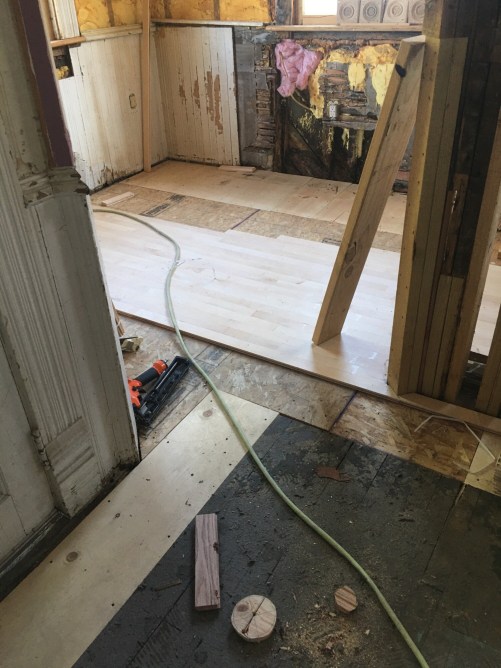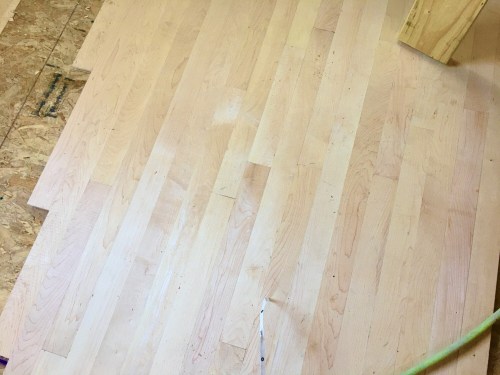KITCHEN FLOORING!

After sitting in the Cross House for several months to acclimate, the maple flooring for the kitchen is now being installed!!!!!!!! You are looking into the servant’s hall. SQUEE!!!!!!!! The original maple flooring in the black section to the lower right. The black is old glue from later flooring. You can also see new pine infill, and OSB board. What a mess.

I am used to having oak flooring installed. Never maple. But the original kitchen flooring in the house was maple. It is extant although too damaged to restore (see first image). So, the new maple will be laid over the original maple and maybe, some day in the fixture, somebody might take up my maple floor and restore the 1894 maple floor.
Maple was a common wood choice for kitchens when the Cross House was built. I have no idea why. Suggestions?
I also have no idea of what to finish the maple with. What was common in 1894? Any ideas?
Oh, and again…SQUEE!!!!!!!!
17 Comments
Leave a Comment
Your email address will NEVER be made public or shared, and you may use a screen name if you wish.


I read in an article in Old House Online that, “maple flooring was used in kitchens due to it’s strength and resilience, since it had no open pores that might absorb spills.” The article goes on to say these floors were finished with coats of orange shellac and then waxed but it required regular maintenance when scratched or worn to clean off the finish and re-apply. Sounds like a load of work to me.
I don’t really know much about flooring, but I do know that the floors we put in our house 3 years ago are maple. They are dark brown, and shiny, and look beautiful when clean but show everything. Dark and shiny is not practical and I’m glad our kitchen is tiled. When we were getting quotes for installation one contractor told us maple is very squeaky. I don’t find they are at all squeaky, but they’ve been in for 3 years and my house is 9 years old, so maybe eventually over time they will be.
It was common at the time and hard AF. It’s a great floor for high traffic, high workload areas. See also: every gym floor in America for nearly 100 years. I even worked in a food manufacturing plant that still retained its original maple floors in some of the production areas. I adore it and would put it in a house in a second.
I had original maple flooring in the kitchen of our 1885 Victorian. The rest of the house was heart pine. So it was the kitchen floor of choice for a while. Hardness and denseness.
Lots of maple species native to Kansas.
Way back, oak was a more premium product, where as maple was cheaper. That, with its strength and density made it the flooring of choice for kitchens. It really wears well being so hard. I would go with a natural clear finish to show it off. Because of it’s density, maple doesn’t take stain that well. If you are lucky, you will get some bird’s eye and other swirls in it. I love maple floors – almost all kitchen’s in Chicago pre-1928 had it, with oak being predominant in all other areas of the home or apartment.
Maple is a dense wood that can withstand kitchen wear and tear. It’s used in bowling alleys and stores of the era as well.
When we moved into our 1919 Bungalow 26 years ago the kitchen floor was covered with numerous layers of linoleum, tar paper with STICKY glue and zillions of staples. I am tenacious- but if I had known how hard it was going to be to get it off (scrapping an inch at a time with lots of hand blisters) I probably wouldn’t have had the umph. But am SO GLAD we got it down to the original Maple flooring- which in our case runs throughout the entire house. It is so beautiful. It gives me pleasure every single day.
Here in the NW we have Big Leaf Maple. I don’t think it’s used commercially to any degree, though lots of home lumbermen have it . My husband made a maple counter for the kitchen using it, and I was REALLY REALLY surprised at how dark it was when oiled. I used mineral oil like a cutting board.
You can see a picture here: https://www.oldhousedreams.com/user/2486/?profiletab=photos
(House album, 28th picture)
Another thing to keep in mind: Over the years of working with wood, I have noticed that most lumber these days is not nearly as dense as it used to be, so it takes stains better. This can be good or bad. I have never used shellac, colored or otherwise, so I don’t know if it would be an issue.
Also, because I was curious, I have a Rock Maple dining room set. I sanded off a bit of the ugly finish and oiled it with mineral oil. It didn’t darken at all. As far as I know, Rock Maple is mostly what is used commercially.
Try a little denatured alcohol on you table in a hidden spot and see if the table is shellacked. It might lighten it a bit. If it’s shellac you might take it all the way down to almost the wood. Then you can use a clear shellac to put more layers back on resulting in a lighter color.
I love your sink.
Our 1898 original kitchen floor is maple and is in great condition! It’s a very light golden color.
Maple is such a hard wood….maybe that is why it would be good for a kitchen floor! My previous kitchen cabinets were maple as was the trim. Was very tricky to stain.
Maple is an excellent flooring. It is very hard, and wears well. It’s easy to finish, and easy to bleach should it become stained. My paternal grandmother owned 3 duplexes in Milwaukee, all had hard maple flooring throughout. After a gentle sanding and refinishing, all looked new.
It’s a hard wood. If it was common it might have been less expensive than oak. But for that area they would have wanted a hard wood because of all of the foot traffic. Likely it was less expensive than oak but more durable than pine. That’s my guess.
By laying it over the original won’t that raise the floor a bit? Will you have to trim all of the doors? Plus it will cover the baseboard another half to three quarters of an inch so raise the shoe too.
Have you decided on any stain or sealant for the floor? It should be something durable so you’ll likely have to go modern.
My Victorian had that same looking black glue on the floors. I used a wall paper steamer to remove it. Set on the floor for a few minutes and scrape it off with a puddy knife. Works great , although it takes quite a bit of time.
Maple is a closed-pore wood, and it is very hard and stain resistant. Most of the time, Victorian-era kitchens used maple with no finish, and it was scrubbed regularly with sand to get rid of grease stains and the like.
Steven, a few decades ago it was discovered that many great houses in England had floors in the important rooms which were NOT originally stained and varnished, but kept bare and cleaned with sand!
Bit by bit, a new trend developed with these ancient floors being stripped and kept bare and raw-looking. Albeit graced with exquisite rugs!
I’m tempted, tempted, to do the same with my kitchen!